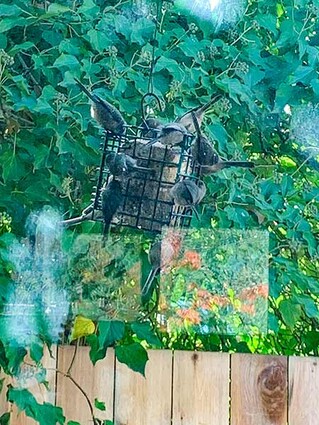A bevy of bushtits
Last updated 11/17/2020 at Noon

Kendra Anderson
A bevy of bushtits; just half of the 20 that were there just before my daughter-in-law got up to the window to shoot their picture.
Note: This story is dedicated to Alex Trebek, the longtime host of Jeopardy! who has gone out among the stars.
Another plus has popped up for Sue and me on leaving Sisters and coming over here to The Swamp to live near our son Caleb and his family in Eugene: a bevy of bushtits, and other wildlife coming to our feeders and water feature. They’re coming nearly daily in a mob to our suet feeder.
Mobbing everything is what bushtits do, and they do it with 100 percent cooperation and gusto, even when nesting.
I’ve only seen one bushtit nest, and that was when I was working for OMSI back in the 1960s, living on my little “U-Pick” farm outside of Beaverton. At first, I thought a silly wind had flipped an old sock into the lower branches of a fir tree in my backyard. But as I stood there looking at it, suddenly a tiny bird went zipping past my head and dove directly into the top of the sock.
“What the…?” I thought, and moved a little closer. As I stood there, still as a cat watching a mouse, another tiny bird came out of the shrubs like a grey blur and also popped into the top of the sock.
That was when it hit me: It wasn’t a “sock” at all, but a bird nest. Then I went a little closer and could see it was made of plant material, not sewn together tightly, but just small chunks of what looked like some kind of leafy mesh, sort of hooked together.
At about that moment three tiny birds came zipping out and what I noticed (I was standing that close) was their tiny beaks and the color of their eyes: two had yellow and one had black eyes.
It wasn’t until I got to breaking open the books on birds that I discovered who they were and what the heck was going on in that sock-like nest. I learned that the females were the yellow-eyed ones. Thank goodness the book didn’t say they’d peck my eyes out if I got too close to their nest.
The 20 or so individuals pigging out on my suet feeder just outside my picture window here in Eugene confirmed they enjoy being together in just about everything they do.
Oh, and this being our election year, I have to tell you the proper name for these tiny birds in the U.S. is “American Bushtit,” scientific name, Psaltriparus minimus. I’m not a Latin scholar, so I have no idea what the genus name means, but the species name means “small.”
One of the bird books described them as, “drab birds with light ticking and lisping call notes.” I don’t consider them drab, not for a minute. When they hit my suet feeder there’s nothing drab about their looks, sounds or behavior.
They’re supposed to be “common in woods and mountains of the west,” but you gotta be on the ball, looking and listening to find them “common,” because they are so tiny. But, the real good news is they are not endangered.
A flock feeding in a tree may go almost unnoticed until they fly out, or you suddenly hear them. Then there’s usually twenty or thirty of them flitting by to the next tree.
Thinking over where you find them, it’s not so strange that they do everything in a group. They are very sociable while finding, and feeding on, insects and spiders. And those groups will stay warm and cuddly roosting close together in a tight mass on cold nights.
Hang a suet feeder up that the downy and hairy woodpeckers — along with that beautiful Sisters icon the white-headed woodpeckers — will come to, and bushtits will think they’ve died and gone to heaven — which is where I hope Alex Trebek is hosting these days, and I hope I get to see him.
















Reader Comments(0)